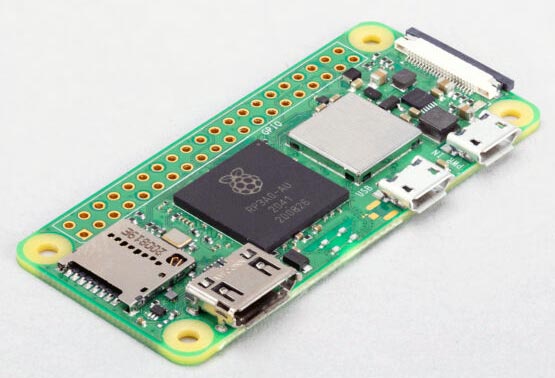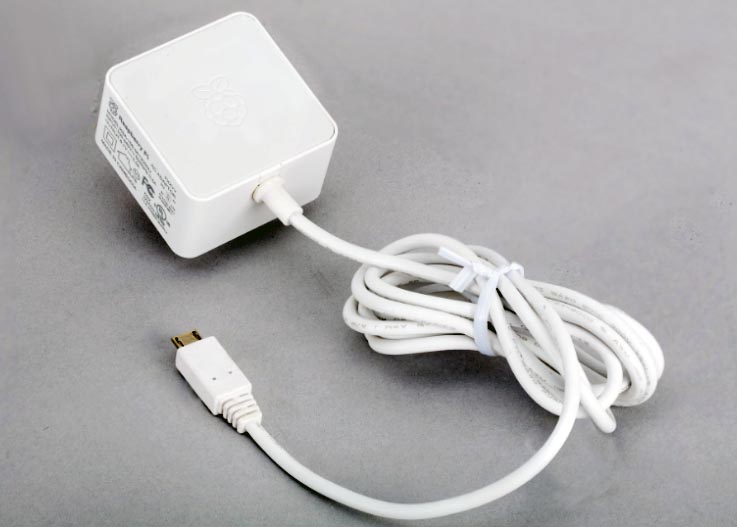It’s been nearly six years since we unleashed the $5 Raspberry Pi Zero on an unsuspecting world. Of all the products we’ve launched, Zero is still the one I’m proudest of: it most perfectly embodies our mission to give people access to tools, and to eliminate cost as a barrier. We’ve sold nearly four million units of Zero, and its $10 wireless-enabled big brother Zero W, and they’ve made their way into everything from smart speakers to hospital ventilators. But where our larger products have grown steadily more powerful over the years, we’ve never found a way to pack more performance into the Zero form factor.
Raspberry Pi Zero 2 W
Priced at $15, Raspberry Pi Zero 2 W uses the same Broadcom BCM2710A1 SoC die as the launch version of Raspberry Pi 3, with Arm cores slightly down-clocked to 1 GHz, bundled into a single space-saving package alongside 512 MB of LPDDR2 SDRAM (Figure 1). The exact performance uplift over Zero varies across workloads, but for multi-threaded sysbench it is almost exactly five times faster.
 |
|
| Figure 1. | Raspberry Pi Zero 2 W. |
Raspberry Pi Zero 2 W is available to buy today from our network of Approved Resellers. If you are a subscriber to The MagPi (Figure 2), you’ll be receiving a free Zero 2 W in the next few days; all new subscribers will receive a unit as a welcome gift.
 |
|
| Figure 2. | Zero 2 W on the cover of The MagPi. |
Raspberry Pi Zero 2 W specifications
Here are the highlights:
- Broadcom BCM2710A1, quad-core 64-bit SoC (Arm Cortex-A53 @ 1 GHz)
- 512 MB LPDDR2 SDRAM
- 2.4 GHz IEEE 802.11b/g/n wireless LAN, Bluetooth 4.2, BLE
- 1 × USB 2.0 interface with OTG
- HAT-compatible 40 pin I/O header footprint
- MicroSD card slot
- Mini HDMI port
- Composite video and reset pin solder points
- CSI-2 camera connector
- H.264, MPEG-4 decode (1080p30); H.264 encode (1080p30)
- OpenGL ES 1.1, 2.0 graphics
If a lot of this looks familiar, it’s because Simon Martin, who designed both Zero 2 W, and the RP3A0 package that powers it, has been able to squeeze all this extra performance into the original Zero form factor. Almost all cases and accessories designed for Zero should work perfectly with the new board, including our own case and selection of cables (Figure 3).
 |
|
| Figure 3. | PHENOMENAL COSMIC POWERS… itty-bitty living space!. |
Packaging magic
The principal barrier to creating a higher performance Raspberry Pi Zero has always been form-factor: with a tiny board, and single-sided component placement, there is no physical room to accommodate both the main system-on-chip (SoC) and a discrete SDRAM package.
Like Raspberry Pi 1, Raspberry Pi Zero and Zero W are built around the Broadcom BCM2835 SoC. This neatly sidesteps the problem by using package-on-package (PoP) technology, in which the SDRAM package sits directly on top of the SoC (Figure 4).
 |
|
| Figure 4. | BCM2835 and 168-ball LPDDR2 PoP memory. |
PoP is an elegant solution if the silicon die in the SoC is small enough to fit in the cavity between the balls of the SDRAM top package. Unfortunately, as Broadcom added first a quad Cortex-A7 (to create BCM2836), and then a quad Cortex-A53 (to create BCM2837), the die outgrew the PoP cavity. From Raspberry Pi 2 onward, we use discrete SDRAM, but this option wasn’t available to us for a future Zero.
But there’s another way to avoid discrete SDRAM, and if you’ve been following Raspberry Pi since the start, you’ve met it before. Back in the day, BCM2835 had a slightly evil twin, BCM2763, which integrated a 128 MB SDRAM die directly into the package along with the SoC die; this arrangement is known as a system-in-package (SiP). BCM2763 was intended for use as a graphics coprocessor for mobile phones, and powered the original Raspberry Pi prototype we demoed back in 2011 (Figure 5).
 |
|
| Figure 5. | BCM2835, but with a goatee. |
Simon, who designed the BCM2763 package at Broadcom a decade ago, now works at Raspberry Pi. In between designing the official mouse and keyboard, the High-Quality Camera, and Raspberry Pi 400, he found time to create RP3A0, a modern SiP which combines the BCM2710A1 die used in BCM2837A1, a 4 Gbit Micron LPDDR2 die, and the decoupling capacitors required to smooth the core supply voltage (Figure 6).
 |
|
| Figure 6. | RP3A0 system-in-package. |
Never one to pass up an opportunity for artistic expression, Simon even managed to squeeze a very low-resolution Raspberry Pi logo into the package ball-out, as you can see from this package and X-ray image (Figure 7).
 |
|
| Figure 7. | Not the smallest Raspberry Pi logo, but possibly the lowest resolution. |
PCB magic
Thermals are a challenge when packing more performance into a small package: can we dissipate the heat generated by the faster processor? In common with other recent Raspberry Pi products, Zero 2 W uses thick internal copper layers to conduct heat away from the processor. If you hold a Zero W and a Zero 2 W in your hands, you can really feel the difference in weight.
All this extra copper translates into higher sustained performance: we’ve found that in a 20 °C ambient environment, an uncased Zero 2 W can run our favorite LINPACK linear-algebra stress test indefinitely without throttling.
Sealed wireless in a can
Next to the large RP3A0 package, you’ll find a large metal shield can (Figure 8), which covers the wireless circuitry on the board and protects it from external interference. Like all Raspberry Pi products since 3B+, Zero 2 W has FCC modular certification, which reduces the compliance workload involved in incorporating it into an end product.
 |
|
| Figure 8. | Shield can can shield. |
New Raspberry Pi Zero 2 PSU
To accompany Zero 2 W, we’re also launching a new official USB power supply (Figure 9). This closely resembles the Raspberry Pi 4 PSU, but with a USB micro-B connector in place of the USB-C connector, and with a slightly reduced peak current rating of 2.5 A. Even this is overkill if you’re powering a Zero 2 W, but it comes in handy if you want to power a Raspberry Pi 3B or 3B+.
 |
|
| Figure 9. | BS 1363 FTW. |
The PSU costs $8, and is available in with the following plug types: US and Canada (type A); Europe (type C); India (type D); UK (type G); and Australia, New Zealand and China (type I).
Raspberry Pi Zero 2 W availability
Today, Raspberry Pi Zero 2 W is available in the United Kingdom, the European Union, the United States, Canada, and Hong Kong. We’ll add new countries as we complete our radio compliance work, with Australia and New Zealand coming up first in November.
Sadly, Zero 2 W isn’t immune to the current global semiconductor shortage. We expect to ship roughly 200k units this calendar year, with a further 250k to follow in the first half of 2022.
